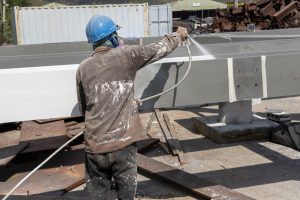Fire is the most common devastating event a building can experience. The structural integrity of a building is vulnerable to high temperatures from a fire because steel melts, wood burns, and concrete cracks! Yet, these are the materials structural engineers use to hold up the building. The materials must maintain integrity during a fire long enough to protect the building occupants and allow firefighters to put out the fire.
Building codes provide guidance on protecting buildings and occupants from the effects of fire. Architects and engineers apply the code provisions to contain a fire so all occupants survive and safely escape the premises. The codes specify how long a building must resist fire to achieve this goal.

So, who drives the decision for the type of fireproofing used to protect the building elements? Both the architect and the engineer have a responsibility to provide these solutions. The structure must be protected, and occupants allowed to escape. So, each professional plays a part in specifying the fireproofing in accordance with the code.
When the owner identifies the use of the building and the occupancy load, the architect references the fire codes to classify the building and identify where fire containments (separations) are located. The architect plans the egress routes (stairs, doors, windows, etc.), applying the fire-resistance rating for the walls, ceilings, and floor assemblies. The types of assemblies are selected and checked against research from fire prevention laboratory studies such as Underwriters Laboratory (UL). These reference standards provide precise details for achieving fire ratings for walls, floors, etc., that are required to comply with fire codes and, when applied, must be constructed precisely as shown. The fire ratings are based on lab tests conducted on the various assemblies to assess how quickly temperatures reach unacceptable levels.
In some cases, precise assemblies are not practical for various reasons and, still, the building element must be protected per the code. Faced with this task, the architect and engineer must now collaborate in preparing, reviewing, and approving fire protection details.
For instance, a popular theme in modern office interiors is an industrial look with an exposed structure. The columns and beams supporting the building have an aesthetic appeal desired by the architect. These support members must be protected without compromising the aesthetics. A popular alternative to sprayed-on cementitious fireproofing, in this case, is to employ intumescent paint or mastic coatings that are much thinner and allow the structural elements to be expressed. These coatings have been developed to swell when heated to protect the structure. They protect the steel while satisfying the fire rating requirement.
Sometimes the application of fireproofing impacts the gross square footage calculation the developer wants to maximize. For example, enclosing the columns with a fire-rated assembly reduces the square footage and reduces the rental fee the developer can request from the tenants. With a multi-story building, the reduction in rentable space can have a substantial negative impact on the cost-benefit to the investors.
Floor-to-ceiling heights can be affected by the choice of floor fire protection. The structural engineer may choose to increase the slab thickness to achieve a fire rating dictated by the code. This approach avoids the need for sprayed-on fire protection to the underside of the slab. Of course, exposed beams need to be protected, but eliminating the need for fire protecting the slab greatly reduces cost. The impact of this decision is a slight reduction in the floor-to-ceiling height, possibly affecting the architectural design.
Residential buildings are often constructed with reinforced concrete. This material provides built-in fire separation, as concrete has excellent fire resistance, eliminating the need for additional applications or assemblies. But the flexibility of the structure for future modifications is reduced. It is more difficult to cut a hole in a reinforced concrete structure than a steel or wood structure.
Numerous options are available for protecting structures; each one has advantages and disadvantages. The priorities of the owner drive the choices. What is the dominant function of the building? Who uses it? What is the expected life cycle? These are questions that should be answered for all elements of a building design process. And, fire protection is a significant consideration when decisions are reached.
Who should specify? It is a collaboration between knowledgeable architects and structural engineers to consider the tradeoffs inherent to different approaches. Sometimes a compromise but, in the end, protection of life and property drives the final decision. The wisdom of these decisions is not apparent immediately but instead years down the road. If a fire occurs, the owner, residents, and the public will be relieved that their building protected the occupants and preserved the property so firefighters could safely extinguish any fire.■
